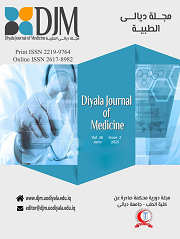Estimation of Sodium, Potassium, and Calcium Serum in Patients with Asphyxiated Neonates
Main Article Content
Abstract
Background: Birth asphyxia is a critical neonatal condition characterized by the failure to initiate and sustain breathing at birth, often due to impaired cerebral blood flow. Electrolyte imbalances may contribute significantly to its morbidity and mortality.
Objectives: To assess the serum sodium, potassium, and calcium levels in neonates with birth asphyxia of varying severities and healthy controls.
Patients and Methods: A hospital-based cross-sectional study was conducted at Al-Batool Teaching Hospital in Diyala, Iraq, from June to September 2023. A total of 200 term neonates were enrolled, 80 with birth asphyxia (defined by an Apgar score <7 at 5 minutes) and 120 healthy neonates as controls. Blood samples were collected within the first 24 hours of life, and serum levels of sodium, potassium, and calcium were measured using standard photometric methods.
Results: Hyponatremia (<130 mmol/L) was observed in 51.3% of asphyxiated neonates. Hyperkalemia (>5.2 mmol/L) was found in 50% and hypocalcemia (<2.2 mmol/L) in 55% of cases. Compared to controls, asphyxiated neonates had significantly higher potassium levels (p < 0.05) and lower calcium levels (p < 0.05); however, differences in sodium levels were not statistically significant (p > 0.05). Electrolyte abnormalities were more pronounced in neonates with altered tone, sucking, respiration, and heart rate.
Conclusion: Hyponatremia, hyperkalemia, and hypocalcemia are prevalent in neonates with birth asphyxia and correlate with clinical severity. Early identification and management of these disturbances are vital to improving outcomes and reducing neonatal morbidity and mortality.
Keywords: Birth asphyxia, Neonate, Hyponatremia, Hyperkalemia, Hypocalcemia.
Downloads
Article Details

This work is licensed under a Creative Commons Attribution 4.0 International License.





